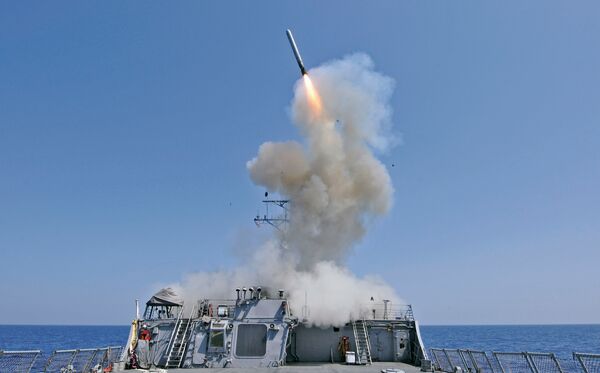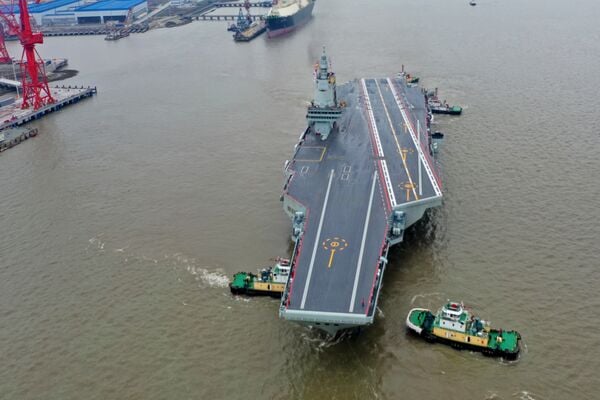- About
- Intara
- Capabilities
- Advisory
- Resources
- News
- Store
Japan accelerates stand-off missile programmes amid tense security environment
05 October 2023
by Ridzwan Rahmat


The Arleigh Burke-class guided-missile destroyer USS Barry is seen here launching a Tomahawk cruise missile. Japan is seeking to accelerate its acquisition of this capability. (US Navy)
Japan is accelerating efforts to procure selected stand-off weapons, including the US-supplied Tomahawk cruise missile, amid deteriorating security conditions in the region.
The matter was announced by the Japanese Ministry of Defense (MoD) on 5 October.
“The Ministry of Defense and the [Japan] Self-Defense Forces will strengthen their stand-off defence capabilities in order to deter and eliminate the invasion force into Japan at an early and distant stage,” reads the announcement.
“In light of the more severe security environment, Minister of Defense Kihara instructed us to further accelerate the construction of stand-off defence capabilities,” it added, in reference to Minoru Kihara, who assumed the post on 13 September amid a cabinet reshuffle.
As part of the effort, the Japanese MoD is now considering to acquire domestically produced stand-off missiles at an earlier date, the ministry said.
France orders first long-lead items for PA-NG carrier
03 May 2024
by Kate Tringham


An artist's impression of the French Navy's PA-NG next-generation carrier. (MO Porte Avions)
The French defence procurement agency (Direction Générale de l'Armement: DGA) has placed the first order for long-lead items for the country's future Porte-Avions Nouvelle Génération (PA-NG) next-generation nuclear-powered aircraft carrier (CVN), the French Ministry of the Armed Forces has confirmed.
In a 30 April announcement, the French defence ministry said the DGA had awarded a contract worth EUR600 million (USD642.7 million) to the PA-NG programme's industrial prime contractor MO Porte-Avions (a joint venture of Naval Group and Chantiers de l'Atlantique), and nuclear reactor developer TechnicAtome, covering the provision of long-lead elements related to the ship's nuclear propulsion, namely the K-22 nuclear reactors, their containment structures, and steam generation machinery.
The contract paves the way to start manufacturing these elements, with work expected to continue from 2024 to 2029 in advance of the start of construction of the aircraft carrier, the defence ministry said.
China's third aircraft carrier begins maiden sea trials
02 May 2024
by Ridzwan Rahmat


China's third aircraft carrier, seen here as it embarked on its maiden sea trials on 1 May 2024. (Pu Haiyang/VCG via Getty Images)
China's third aircraft carrier has embarked on its maiden sea trials, state-controlled Xinhua News Agency announced in its report on 1 May.
The carrier, Fujian , left the Jiangnan Shipyard in Shanghai at around 0800 h local time on the day of the announcement. These trials will primarily focus on testing the “reliability and stability of the aircraft carrier's propulsion and electrical systems”, reads the Xinhua report.
“Since its launch in June 2022, the Fujian has completed its mooring trials, outfitting work, and equipment adjustments. It has met the technical requirements for sea trials,” the report added.
Fujian was launched by Jiangnan Shipyard in June 2022. It is slated to be the People's Liberation Army Navy's (PLAN's) third aircraft carrier overall, but it is the service's first vessel to be configured for catapult-assisted take-off but arrested recovery (CATOBAR) aircraft operations.
New labour deal touted as possible pathway for national workforce model for naval ships
01 May 2024
by Michael Fabey


The US Navy has begun to improve its current public shipyards, such as the Portsmouth Naval Shipyard, shown here. (US Navy)
A new labour agreement signed on 29 April that seeks to build a rotational workforce of skilled welders could eventually serve as template for a national workforce arrangement for work on naval ships, according to Edward L Bartlett Jr, founder and CEO of Bartlett Maritime Corporation (BMC) – the company that brokered the deal.
The impetus for the rotational welders was a plan to use such a workforce to work on naval ships in Charleston, South Carolina, Bartlett told Janes in an interview on 29 April.
BMC hopes to prove out the concept through the recentlysigned labour deal and similar follow-on agreements. BMC has also proposed to construct and operate component repair facilities in northeast Ohio with an option to build a new public naval shipyard in Charleston.
Japan is accelerating efforts to procure selected stand-off weapons, including the US-supplied Tomah...
Latest Podcasts
Using OSINT to support law enforcement
Ritu Gill, Intelligence Analyst, joins Harry and Sean to discuss the practical use of OSINT to support law enforcement. Ritu discusses it’s use in supporting risk assessments and classified or closed sources of intelligence. She also discusses t...
Listen nowJanes Case Studies
Using Janes Intara to build a common intelligence picture: Russian build up on the Ukrainian border
View Case StudyNews Categories
 Sea Details
Sea Details